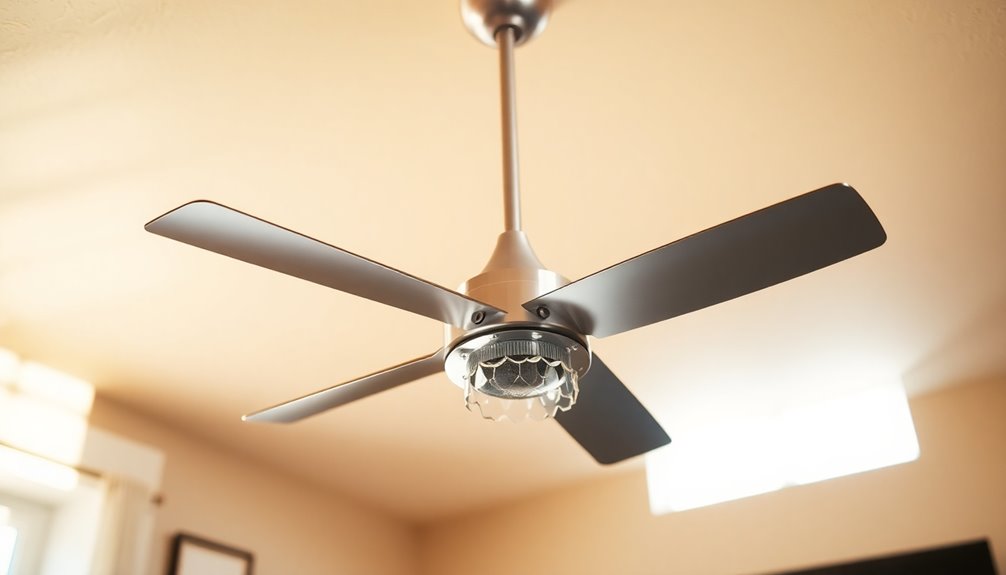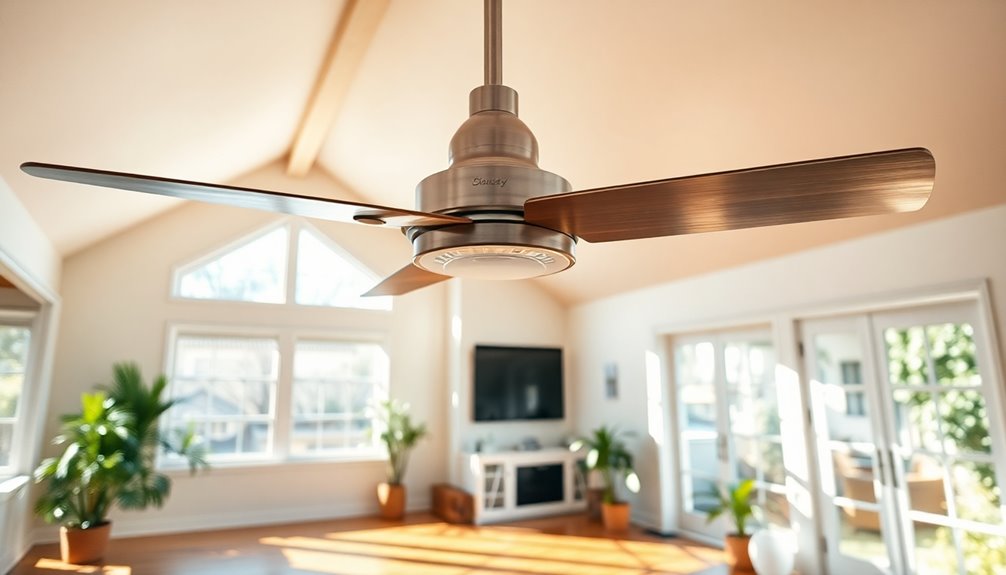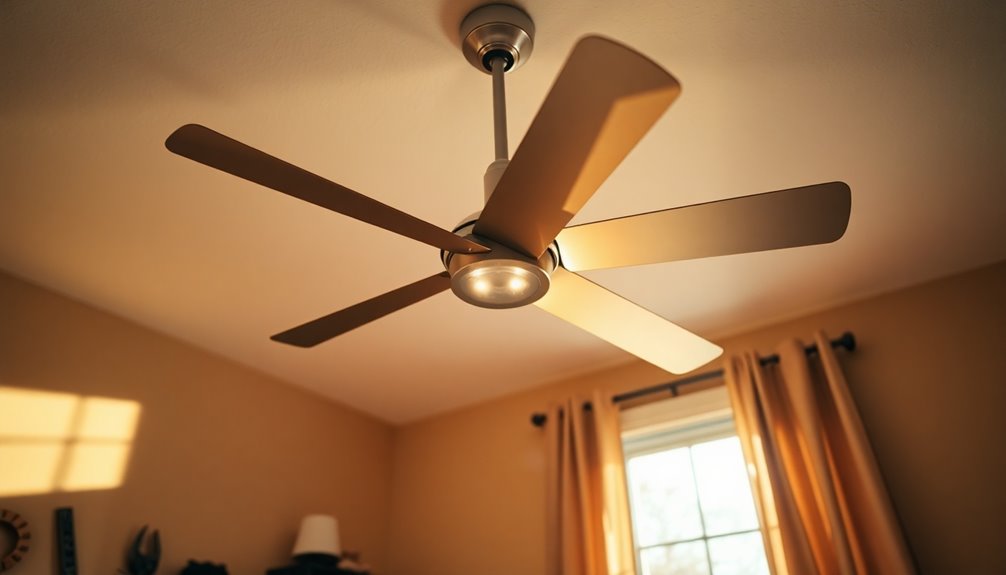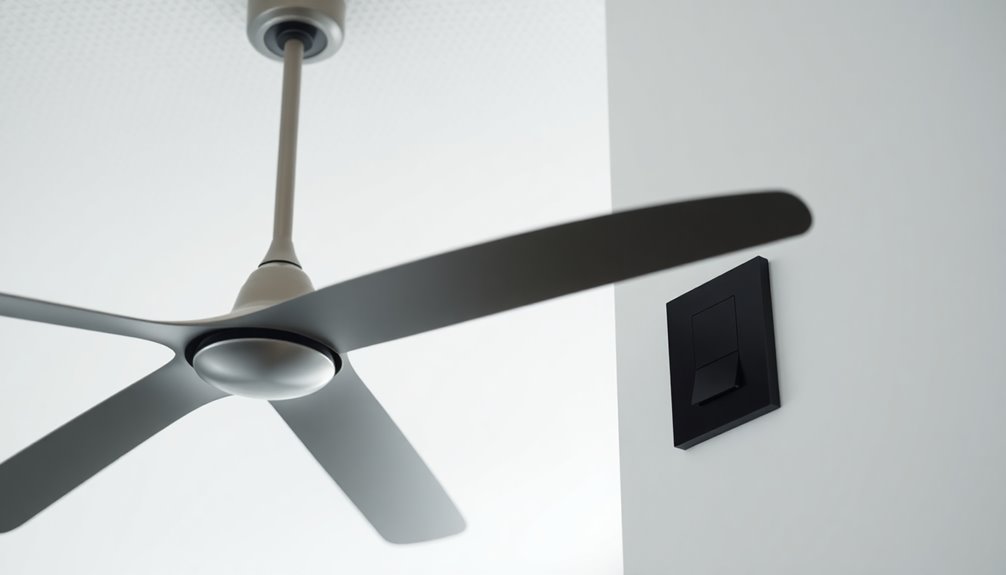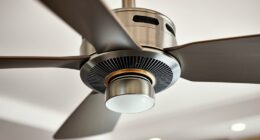The average cost to install a ceiling fan ranges from $200 to $700, which includes both the fan and labor. If you're using existing wiring, you could spend between $100 and $500. However, installing new wiring can push costs up to $2,000. Expect to pay around $249 on average for labor, and factor in a 1 to 3-hour job duration. Remember, local rates and seasonal demand can affect prices. If you want to explore more strategies for managing your budget or finding the right fan, there's a lot more to uncover.
Key Takeaways
- The average installation cost for a ceiling fan ranges from $200 to $700, including the fan and labor.
- Basic installation with existing wiring typically costs between $100 and $500.
- New wiring installations can significantly increase expenses, potentially reaching up to $2,000.
- Labor rates for installation usually average around $249 and can vary from $50 to $200 per hour.
- Utilizing existing wiring and installing multiple fans at once can help reduce overall costs.
Cost Overview and Breakdown

When considering the cost of installing a ceiling fan, you'll find that the average expense ranges from $200 to $700, covering both the fan itself and labor. The ceiling fan installation costs can vary considerably based on several factors.
If you're working with existing wiring, basic installation typically runs between $100 and $500. However, if you need new wiring, you could be looking at expenses as high as $2,000.
The average installation labor cost is around $249, but it's crucial to note that local labor rates and any additional features you choose can influence the total costs. Ceiling fan prices alone can range from $85 to $639, depending on the model and brand you select.
Additionally, be aware that seasonal price fluctuations may impact installation costs, so timing your purchase might save you some money.
On average, the installation process takes between 1 to 3 hours, depending on the complexity of the job. By understanding these factors, you can better prepare for the cost of installing a ceiling fan in your home.
Factors Influencing Installation Costs

When you're considering the installation of a ceiling fan, several factors can impact the overall cost.
Wiring requirements can range widely, and labor rates vary based on your location.
Plus, the type of fan you choose can greatly influence your final expenses.
Wiring Requirements Impact Costs
Wiring requirements greatly influence the cost of installing a ceiling fan. If you're using existing wiring, installation costs typically range from $100 to $500.
However, if new wiring is necessary, expenses can soar up to $2,000 due to the requirement for additional materials and labor. The complexity of your wiring setup also plays a vital role; challenging installations can lead to higher labor rates and material expenses.
If there's no electrical box in place, you'll need to install a fan-rated junction box and possibly a fan brace, further increasing your costs.
Furthermore, if you want additional features like built-in lights or smart controls, expect to pay an extra $100 to $300 for the installation, depending on how intricate the setup is.
Finally, local labor rates can vary considerably, ranging from $50 to $200 per hour, adding another layer of cost associated with wiring requirements.
Labor Rates Variability
The cost of installing a ceiling fan isn't just about the wiring; labor rates play a significant role too. You might be surprised to learn that labor rates can vary widely, generally ranging from $50 to $200 per hour. This fluctuation often depends on whether you hire a professional electrician or a more general handyperson.
Several factors can influence these installation costs:
- Geographic location: Labor rates differ from one area to another based on demand and local economics.
- Installation complexity: If your ceiling fan installation requires new wiring or involves tricky access, expect higher labor costs.
- Seasonal fluctuations: Rates can increase during peak installation times, like summer months.
- Experience level: Hiring a professional electrician for complex setups typically boosts labor costs due to their expertise.
- Time required: More intricate installations naturally take longer, increasing overall costs.
Additionally, understanding the average cost of common home installations can provide a better context for budgeting.
Being aware of these variables can help you budget more effectively for your ceiling fan installation.
Don't forget to factor in labor when calculating your total project expenses!
Fan Type Considerations
What type of ceiling fan you choose can greatly impact your installation costs. Standard fans typically range from $50 to $300, while low-profile fans for lower ceilings cost the same.
If you're considering more complex options like hanging propeller fans, expect to pay between $150 and $550, especially for high ceilings. Directional fans, which allow for adjustable airflow, have installation cost ranges from $150 to $800.
On the other hand, rotational fans can get pricey, costing between $200 and $1,500 depending on their features.
Don't forget about additional costs; integrated lights can add $100 to $300 to your overall expenses, while smart technology options may increase your bill by another $150 to $300.
The presence of existing wiring can lower your installation costs considerably, usually ranging from $100 to $500. However, if you need new wiring, be prepared for costs that could reach up to $2,000.
Finally, ceiling fan height requirements may require extra equipment like downrods, further influencing both labor and material costs during installation.
Types of Ceiling Fans and Prices

When it comes to ceiling fans, you'll find a variety of options that can fit your needs and budget.
Standard ceiling fans generally range from $50 to $300 for installation, while specialty fans might cost you more.
If you're considering outdoor options, be prepared for different pricing that reflects their unique features.
Standard Ceiling Fan Costs
Installing a ceiling fan can enhance your home's comfort while adding a stylish touch.
When considering the cost of a ceiling fan, it's crucial to factor in both the fan price and professional installation costs. Standard ceiling fan installation typically ranges from $50 to $300, depending on the type of fan and existing wiring conditions.
Here's a quick breakdown of average costs for various fan types:
- Low-profile ceiling fans: $50 to $300
- Hanging propeller fans: $150 to $550
- Directional ceiling fans: $150 to $800
- Rotational fans: $200 to $1,500
- Complex installations: Higher costs based on features
These costs can vary considerably, so it's a good idea to shop around and get quotes.
Additionally, if you're opting for a more intricate design or if your wiring needs an upgrade, you might want to budget for those extra expenses.
Always remember that investing in a quality fan and professional installation can lead to long-term savings on energy bills while enhancing your living space's overall ambiance.
Specialty Ceiling Fan Options
If you're looking to elevate your home's comfort and style, specialty ceiling fans offer a range of options tailored to different needs and aesthetics.
Low-profile fans, perfect for rooms with low ceilings, typically cost between $200 and $650. If your ceilings are higher, consider hanging propeller fans, which usually range from $300 to $900, depending on their features.
For those who appreciate versatility, directional fans allow you to adjust airflow direction and generally range from $300 to $1,200.
If you want something more powerful, rotational fans, with their advanced functionality, will set you back between $350 and $1,850.
When planning the installation of a new specialty ceiling fan, remember that costs can add up quickly.
While the average ceiling fan installation varies by type, specialty fans often require more intricate setups.
It's important to account for these additional expenses in your budget.
Outdoor Ceiling Fan Prices
Specialty ceiling fans can elevate indoor comfort, but outdoor ceiling fans bring that same level of style and functionality to your patio or porch.
When considering outdoor ceiling fan prices, you'll find a wide price range, typically from $250 to $3,000. This range largely depends on the fan's features and durability to withstand harsh weather conditions.
Here are some key factors that influence your outdoor ceiling fan budget:
- Wet-rated vs. Damp-rated: Choose fans designed for outdoor use to guarantee safety.
- Size matters: Larger fans are ideal for spaces over 350 square feet.
- Features: Options like remote control and integrated lighting can raise the price.
- Energy efficiency: Investing in energy-efficient models might save you money long-term.
- Installation costs: These can start around $70 and go beyond $4,000 for complex setups.
When selecting your outdoor ceiling fan, keep these factors in mind to find the perfect blend of style, functionality, and budget for your space.
DIY vs. Professional Installation

Deciding between DIY and professional installation for a ceiling fan can greatly impact your budget and peace of mind. If you're handy and have a solid grasp of electrical work, you might save between $50 to $200 on labor costs by tackling the job yourself.
Basic DIY installation typically runs from $100 to $275, which includes learning time and materials. However, make sure you adhere to safety standards and local codes. Many people find that utilizing essential oils for stress relief can help create a calming environment while they work on their installation. Additionally, it's essential to have an understanding of safety standards to avoid potential hazards during the installation process. Using a vacuum with HEPA filters can also help keep the workspace free from dust and allergens, ensuring a safer environment while you work.
On the other hand, hiring a professional can provide peace of mind, especially for new wiring or complex setups. The average cost of an electrician ranges from $60 to $250 per hour, with installation taking between 1 to 2.5 hours, depending on the complexity.
For simpler projects using existing wiring, a local handyperson may charge around $60, offering a budget-friendly option.
Ultimately, the choice between DIY vs. professional installation hinges on your comfort level with electrical work and your willingness to invest time. Additionally, considering average installation costs can help you better assess your financial commitment to the project.
Weigh the costs carefully to make sure you make the best decision for your ceiling fan installation.
Tips for Cost Savings

When it comes to saving money on your ceiling fan installation, there are several strategies to contemplate.
By planning ahead and making smart choices, you can greatly lower the cost to install.
- Use existing wiring: If you're installing in areas with existing wiring, you'll save on additional expenses.
- Install multiple fans: Hiring a professional to install several fans at once can reduce hourly contractor rates, saving you on labor costs.
- Shop off-season: Purchasing ceiling fans during the off-season can lead to discounts, making the average installation cost of around $249 more manageable.
- Consider ENERGY STAR-rated fans: Investing in these fans can lead to long-term utility savings, offsetting those initial installation costs.
- Opt for a handyperson: For basic replacements within current wiring setups, hiring a handyperson instead of a professional to install can save you between $50 to $200 on labor.
Ceiling Fan Accessories and Costs

While you may focus on the cost of the ceiling fan itself, it's important to contemplate the accessories that can enhance its performance and functionality.
For instance, if you're installing a fan in a room with high ceilings, you might need extension downrods, which typically cost between $10 and $75. If your ceiling has a pitch over 34 degrees, a sloped ceiling adapter priced around $37 is necessary for proper installation.
In addition to these essentials, consider additional control options. Wall switches or remote controls can range from $30 to $100, depending on their features. If your fan doesn't come with a remote receiver, you'll need to budget about $30 for that as well.
Investing in smart technology or dimmer switches can further enhance how you use your ceiling fan, but be aware that costs for these options can vary widely based on the specific features you choose.
All these ceiling fan accessories add to your ceiling fan installation cost, so it's wise to account for them in your overall budget.
Budget Management for Installation

Installing a ceiling fan can be a considerable investment, so managing your budget effectively is key. The average installation cost ranges from $200 to $700, with basic setups typically costing between $100 and $500.
To keep expenses in check, here are some tips:
- Plan for multiple fans: Installing several at once can lower the hourly rates for contractors.
- Consider additional features: Built-in lights or smart controls can add $100 to $300 each to your installation cost.
- Account for unexpected expenses: Job-specific issues can arise, so it's wise to set aside extra funds.
- Don't forget permits and taxes: These can also impact your overall budget.
- Prioritize existing wiring: If possible, use existing wiring to considerably reduce installation costs.
Important Notes on Installation Costs

Understanding the nuances of installation costs is essential for planning your ceiling fan project. The average installation cost typically ranges from $200 to $700, which includes both the fan and labor expenses.
If you're using existing wiring, your installation costs might fall between $100 and $500 for basic setups. However, if you need new installations and wiring from scratch, be prepared for considerably higher costs that can reach up to $2,000 for extensive setups.
Additionally, keep in mind that extra features—like built-in lights or smart controls—can further increase your installation costs by $100 to $300 each. Local labor rates and any necessary permit fees can also affect your total expenses, creating further price fluctuations.
To avoid surprises, it's wise to get multiple quotes from professionals and consider the specifics of your project.
Whether you're working with existing wiring or planning a new installation, understanding these factors will help you budget effectively and choose the right ceiling fan for your needs.
Frequently Asked Questions
How Much Should I Pay to Install a Ceiling Fan?
When you're considering how much to pay to install a ceiling fan, think about a few factors.
Basic installation with existing wiring usually falls between $100 and $500, but if you need new wiring, it could go up to $2,000.
Don't forget about labor costs, which can range from $50 to $200 an hour.
If you want extra features like lights or smart technology, expect to add $100 to $300 to your total.
How Much Does Lowes or Home Depot Charge to Install a Ceiling Fan?
Imagine your living room transformed by a gentle breeze from a stylish ceiling fan.
When you consider installation at Lowe's or Home Depot, you're looking at costs that typically range from $100 to $500.
Factors such as existing wiring or additional features, like remote controls, can influence the total.
Keep an eye out for seasonal promotions, as they might just help you snag a better deal without breaking the bank.
How Long Does It Take an Electrician to Install a Ceiling Fan?
When you hire an electrician to install a ceiling fan, it usually takes between 1 to 3 hours.
If they're using existing wiring, expect it to take about 1 to 2 hours.
However, if they need to deal with new wiring or a complex setup, it might stretch to 3 to 4 hours.
Factors like ceiling height and access issues can also impact the installation time, so be prepared for some variability.
Can the Average Person Install a Ceiling Fan?
Can you install a ceiling fan? Absolutely! If you've got basic electrical knowledge and feel comfortable with wiring, you can tackle this project.
DIY installation not only saves you money but also gives you a sense of accomplishment. Just make sure to read the fan's manual and follow safety guidelines.
While it's doable for most, remember that complex setups are best left to licensed electricians to avoid hazards.
Conclusion
In conclusion, installing a ceiling fan can fit various budgets, but knowing the costs and factors involved will help you make an informed choice. Whether you decide to go the DIY route or hire a pro, it's all about striking a balance. Don't forget to check for any accessories that could enhance your fan's performance—like a remote control, which feels like a tech marvel from the future! With the right planning, you'll enjoy a breezy upgrade in no time.
